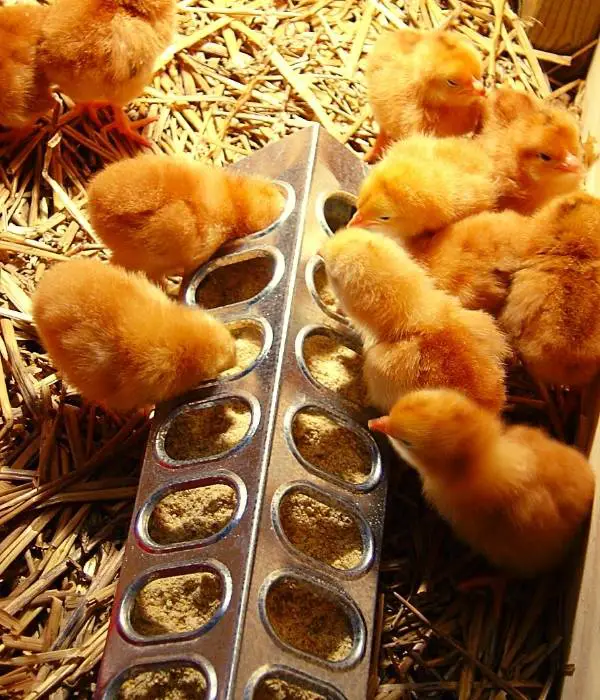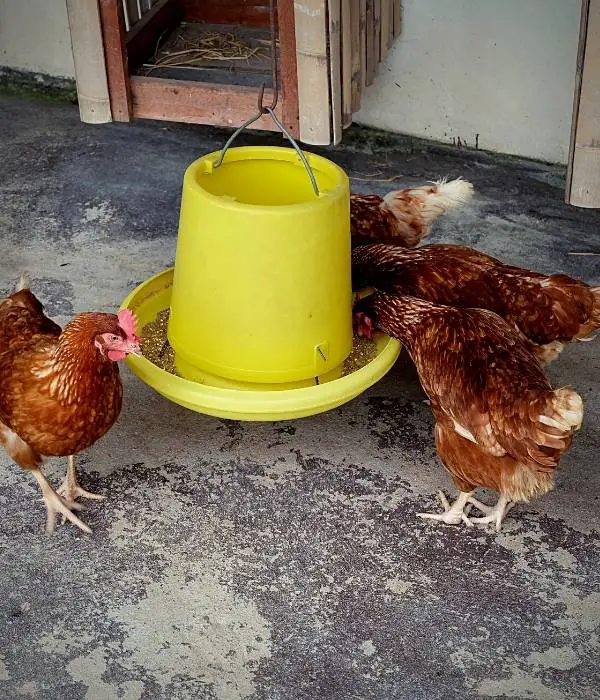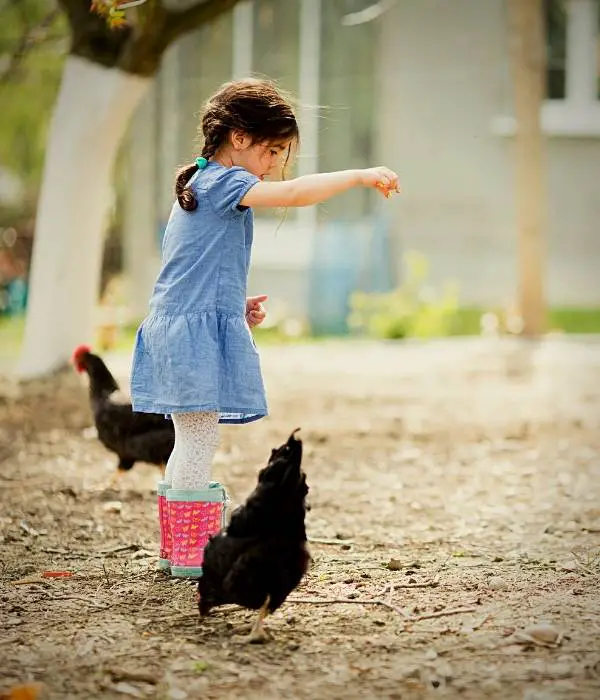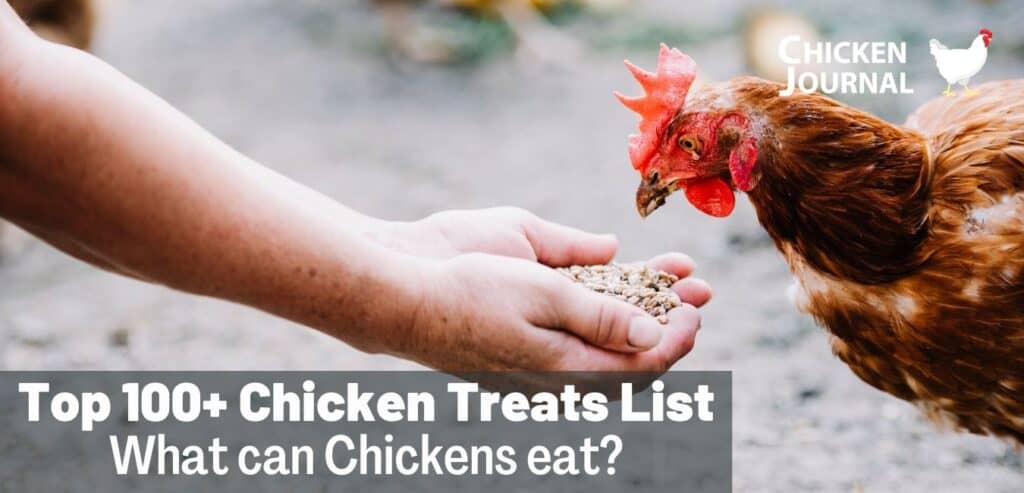If you’re new to poultry farming, you must have complete knowledge about feeding chickens. Understanding how to feed chickens is most important because it’s linked to the flocks’ health and productivity.
We’ve compiled a range of information and resources to help you get started. The intent of this definitive guide is not necessarily to tell you how to feed chickens, but rather how to go about it with the intention of keeping your chickens healthy and happy.
Chickens need different feed at different ages
As with any animal or living thing, chickens are going to require and produce different nutrients as they grow. The needs of a baby chick are different from those of an adult chicken.
In addition to the varying nutritional requirements, an adult chicken will produce eggs, which are also nutritionally different from other meats.
It’s important that your chickens have the right feed available at the right time. If you feed them too much or too little based on what they need, you’ll find that your chickens become sick, weak, and obese.
Chickens are omnivores and eat both plants and animals. If you’ve ever decided to raise chickens, one of your first steps should be to determine what they should eat.
Also read: Best 120+ Chicken Treats To Give Your Flocks
Feeding Baby Chicks

Baby chicks are among the cutest creatures imaginable. It’s easy to see why so many people are initially drawn to the idea of raising chickens.
Unfortunately, many people don’t realize that raising baby chicks can be tedious work. So let’s get started.
Starter feed for chicks
- MEDICATED: Complete chick feed with added Amprolium to...
- FORTIFIED: Manna Pro Medicated Chick Starter Grower is...
- SUPERIOR NUTRITION : Manna Pro Medicated Chick Starter...
- COMPLETE FEED: This feed is specifically formulated to...
- CRUMBLES: This feed is in a crumble form which is just...
Last update on 2025-07-17 / Affiliate links / Images from Amazon Product Advertising API
Chickens are omnivores and, like all animals, need a good balance of protein and carbohydrates in their feed. For baby chicks, the best way to provide this is with a starter feed.
As newborn chicks start to eat, you’ll want to introduce them to adult food. Remember, you’ll have to feed them special baby food until they are old enough for regular adult food.
There are several types of starter foods available. Laying hens will produce the best laying eggs unless you have a second purpose for your backyard chickens.
If you’re raising a number of chickens for eggs, you’ll want to purchase a laying breed. Among the most popular chicken breeds, the White Leghorn is one of the best egg layers. If you have a need for meat, then consider the Cornish Rock and Dominique cross breeds.
How long to feed a chick starter?
While you can feed your chicks starter food until they’re ready to transition to regular chicken feed, it’s not necessary. You can transition your chicks to adult food as early as 8 weeks old.
It’s important that you talk with your local feed store before doing this, though. Starter feed can be higher in carbohydrates than regular chicken food. If you transition your chicks too early, they may get sick.
When transitioning chicks to adult food, you’ll want only to change the type of feed, rather than the type of food that you give them.
For example, you could offer them a mix of both starter and adult feed. It will take time for your chickens to get used to their new type of food, though. If you provide too much food at once, your chickens may become ill from overeating.
Need for Small Size Feeder and Drinker
- 🐣 Feeder & Waterer Combo for Use In Most Chick...
- 🐣 Feeder Base Designed To Keep Chicks From...
- 🐣 Shallow Water Base Design Helps Keep Chicks Safe...
- 🐣 Includes 1 Quart Size Feeder (9.25" H) & 1 Quart...
- 🐣 For Use With Up To 15 Chicks Till 3 Weeks of Age
Last update on 2025-07-18 / Affiliate links / Images from Amazon Product Advertising API
When feeding baby chickens, you’ll want to use a small size feeder and drinker. This allows you to more easily monitor how much food your chicks are eating.
In the case of feeders, it’s also important that you choose one that is lightweight. Otherwise, your chickens may overturn their food. Chicks are prone to overeating, so overloading them with food can be dangerous for their health.
Many feeders and drinkers for chickens are bright and colorful. While it’s not a safety concern, this can get messy in a hurry. It’s best to choose feeders and drinkers that are black or brown in color.
How much to feed baby chicks per day?
If you’re feeding your baby chicks starter food, then you’ll want to feed them three times a day. If you transition them to adult food, then the amount you feed them per day may be less. Replacing their food twice per day should be adequate.
Feeding cockerels and pullets

As chickens mature, their nutritional requirements change. The gender of your chicken can also influence the amount of food you give it, as well as its growth rate. Let’s learn more about feeding cockerels and pullets.
Feeding grower feed to chickens
- USDA certified organic and non-GMO
- 17% crude protein to support muscle development and...
- Fortified to support natural healthy growth
- Non-Medicated crumble form for easy consumption
Last update on 2025-07-18 / Affiliate links / Images from Amazon Product Advertising API
As your chickens grow older, you’ll want to provide them with a more diverse diet. In general, cockerels and pullets will require more protein as they grow.
Feeding them a mix of different nutrients also helps avoid any nutritional imbalance. The best practice is to gradually transition your chickens from starter food to grower feed.
Grower food is also known as “light” feed. This should be easier on your chickens’ digestive systems than starter food.
How long to give grower feed?
At the age of 8–16 weeks, you can transition your chickens to grower feed. It’s best if you work with a local feed store to make this transition.
As chicken farmers are able to adjust the proper supply of nutrients in each type of food, they are best suited to help you find what is right for your chickens.
Need for Medium size feeder and waterer
- AUTOMATIC CUP WATERER - The drinking cup automatically...
- EASY CLEAN CUP WATERER - The unique doubel wall...
- NO-WASTE FEEDER - The feeding port makes chickens can't...
- FEEDER WITH RAIN HOOD - Keep feed always dry, no need...
- 2 GALLON / 10 LBS CAPACITY - Holds 2 gallon water and...
Last update on 2025-07-18 / Affiliate links / Images from Amazon Product Advertising API
As the chicks grow, there is a need to offer more food and water. This shows that there is a need to shift to bigger feeders and drinkers.
If you are starting a small flock of chickens, feeders and waterers of 2-3 gallons are sufficient. Chicken owners with large flocks will need feeders and waterers of up to 4 gallons in size.
How much do you feed a pullet chicken per day?
The feeding rates of chickens depend on the type of feed, their age, and the purpose for which they are raised. A pullet needs an average of 1/4 to 1/3 of a pound a day of food. When fed with a commercial ration, they will usually eat just what they need.
4. Feeding adult chickens (Hens and Roosters)

Feeding an adult rooster or hen is very different from that of pullets and cockerels. They are fully grown chickens and only need to either maintain their healthy life or lay eggs. That’s why you will need layers and breeder feed for hens and roosters.
Feeding layers and breeder feed to chickens
For your older chickens, you’ll want to transition them to layer and breeder feed. This shift occurs when your cockerels reach the age of 9-12 months.
Feeding layer feed to chickens?
- Rich yellow yolks - A high level of xanthophyll, a...
- Calcium Manganese and Trace Minerals - For strong...
- Essential Amino Acids - Enhanced with lysine and...
- Key Levels of Vitamin A, D, E - Strong reproduction and...
- Prebiotics, Probiotics and Yeast - Supports immune and...
Last update on 2025-07-18 / Affiliate links / Images from Amazon Product Advertising API
For adult chickens that are laying eggs, you’ll want to provide them with layer feed or breeder feed. You can use layer feed as long as your hens are laying eggs.
If they’re not laying eggs or you are getting thin shell eggs, then you can transition them to a mix of layer feed and breeder feed.
Layer feed is also known as breeder feed. It’s exactly the same as layer or breeder feed, but this is an older adult bird that has stopped laying eggs. Breeder feed is higher in protein and calcium.
How long to give layer feed?
For chickens that have reached the age of 16+ weeks, you’ll want to transition them to mature feed. This type of feed is higher in protein and calcium.
Mature chicken feed is also known as “mature” or “maintenance” chicken feed. It’s best if you work with a local feed store to find the right food for your chickens.
Chickens are individuals, so adjusting the type of feed can be difficult. Your chickens should get used to their new type of feed gradually.
Need of large size feeder and drinker
- For Chickens 12-weeks and older. INCLUDES: 2 20lb...
- Great for hot days (80°F+), chickens can dip their...
- Designed to be placed in the corner of a chicken coop...
- Place feeder anywhere in your yard/run and the feed...
- Made in the USA with US and Global Parts! 100%...
Last update on 2025-07-18 / Affiliate links / Images from Amazon Product Advertising API
There is a need for large-sized feeders and drinkers when feeding adult chickens. The size of the feeder should be according to your requirements, as chicken farms have different requirements.
If you are breeding chickens, then the size of the feeder should be 4-6 gallons in capacity. If you are growing chickens for meat, then the size of the feeder should be 5-6 gallons in capacity.
How much to feed the hens and roosters?
A normal hen should have 100–150g of feed per day. You shouldn’t overfeed your hens. If you feed them more than 150g of feed, you can expect that they won’t lay eggs. For roosters, the food intake should be around 170 to 200 grams of feed per day.
Feeding Chickens Naturally
Apart from commercial chicken feeds and complete chicken feeds, natural chicken feed can be used to improve the condition of your chickens.
This can be done on a small or large scale basis depending on the size of your flock. These are the 3 most common natural chicken feeds.
Free ranging
This is where the chicken is left to feed on natural vegetation. They use their beaks to dig or scratch through the ground in search of seeds, insects, worms, and grubs. You will still have to provide your chickens with some type of supplementary food.
Grits
If your chickens are free-ranging, then it’s important to give them grits. This is a type of sand that is ingested by chickens to aid in digestion.
It’s best if you provide your chickens with a type of grit that they can’t pick up and carry away. Grits also help keep their digestive system in order.
Diatomaceous earth
Diatomaceous earth is mostly used to control parasites in chickens, and it’s also a natural source of nutrients. This is an ingredient that chicken owners can purchase and store for at least 2 or 3 years for future use.
It’s important to provide it to them without mixing it with feed. You can just sprinkle it on your chicken’s food.
Eggshells
Egg shells are a great source of calcium, and the shells can be purchased from any store. Use one-third of the egg shell to provide your chickens with calcium.
If you’re not sure if they need calcium, then you can give them any other type of calcium source instead.
Feeding treats to chickens

Feeding chicken treats should be done for the purpose of improving the health of your chickens. If you have chicks and baby chickens, then it’s best not to feed any treats.
When to give treats to chickens?
Chicks are supposed to be fed from 3 weeks to 2 months, and this is the only time you would offer them a treat. Treats should be given as snacks for young chickens.
Few best chicken treats for feeding chickens
There are different types of treats available on the market. Some of the most common treats given to chickens include:
Raisins: Raisins are rich in iron and potassium. These treats promote the good and healthy growth of your chickens. Raisins can be either big or small.
Carrots: Carrots can either be boiled or raw. They are rich in carrots and are good for the growth of baby chicks.
Sunflower: These treats are rich in proteins, fats, and other minerals. Sunflower seeds are also rich in protein, and they are great treats for your chickens.
Wheat bran: Wheat bran is filled with healthy fats, vitamins, and proteins. It’s a great treat for your chickens.
Strawberries: Strawberries are one of the best treats for your chickens. You can either give them fresh strawberries or make strawberry jam from the leaves. Strawberries are rich in protein and vitamins.
Lettuce: Lettuce is rich in proteins, vitamins, and minerals. It’s a great treat for chickens.
Pumpkin seeds: Pumpkin seeds are loaded with protein, fat, and minerals. They are great as a treat for chickens.
Nuts: Nuts are rich in proteins and fats. You can either dry the nuts and grind them or give them raw.
Oatmeal: Oatmeal is a great treat for your chickens. They love oatmeal and they enjoy it more than corn.
How many treats should you feed the flocks?
Treats should be limited to 2 tablespoons per week. This should be given as a treat to your chickens. Too many treats can make your chickens sick.
Feeding Table Scraps to chickens
Table scraps are scraps of table food that would have been eaten by humans. The food can be either fresh or stale, depending on the taste of your chickens.
Feeding table scraps to chickens is a great way to improve the health and condition of your chickens.
Examples of table scraps include:
- Rice, pancakes, waffles, roasted potatoes, etc.
- Cooked vegetables include broccoli, carrots, and celery.
- Cooked meals such as spaghetti and rice.
Problems caused by poor feeding of chickens
Poor feeding results in poor health and a weak flock. Below are some of the problems commonly associated with poor feeding:
Weak legs
Weak legs are caused by a lack of fat. The growth and development of the legs depend on the amount of fat present in the chickens.
You need to feed your hens a healthy diet to promote the growth of their legs. This should be done by using complete chicken feed.
Poor feathering
Feathers are used by chickens to keep themselves warm and to protect their bodies from harsh weather conditions. The ability of the feathers to keep the chickens’ bodies warm depends on their quality. Diet is the key to good feathering in chickens.
Low-quality eggs and shells
When chicken feed is not provided in good quality, it can result in low-quality eggs and shells. When chicks are not fed well and are weak, then the eggs and shells produced by them will also be of low quality.
Diseases
Poor feeding of chickens may result in the development of diseases. Some of the common diseases found among chickens are Staphylococcus, Newcastle’s Disease, and Avian Infectious Laryngotracheitis (ALT).
FAQs on feeding chickens
Should I give scratch feed to my chickens?
It is advisable to give scratch feed to your chickens as this is a good diet for them. Scratch feeds keep your chicken warm all through the night.
The maximum percentage of scratch feed you should provide your chickens should be 10%. You can give it without mixing it with their food. The best time for giving your chickens a scratching meal is during the night.
Should I feed an additional supplement to my chickens?
Additional supplements and vitamins are important in improving the health of your chickens. Specialized supplements are recommended for your chickens before they get used to chicken feed.
What to feed chickens during molting?
Molting is the natural process of shedding feathers and growing new ones. It’s very important to know when chickens molt as it results in a loss of production.
You should provide your chickens with high protein feeds during this time and ensure that their bodies have enough nourishment. These feeds include sunflowers, mealworms, and scrambled eggs.
How do I know if my chickens are getting enough food?
There are a few ways to determine if your chickens are getting enough food. One of them is that when you visit the coop during the day or evening, you should see that the chickens are active and have a good weight to them.
Their droppings should be firm, dry, and small. Another way to tell is when you feed your chickens, they should eat all the food in the feeder.
Production is also a way to determine if your chickens are getting enough food. Check their egg production to understand if they are healthy or not.
Conclusion
As you can see, choosing the right food is not an easy task, and it’s important to have a good guide to help you out.
Also, you have to choose the right feed at different ages of chickens. I hope this article will help you to understand what to feed our chickens and how to feed them.








